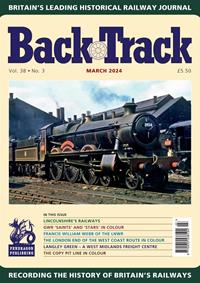|
|
Contents Listing - Articles & Features in this issue
Great Northern (Ireland) Railway 4-4-0s
Cafeteria Cars
Remembering Connectrail - Part One (March 1995-November 1997)
Four Yorkshire Stations - A Ninetenth Century Perspective
Strikes, Theft and Fraud at Liverpool Road....
"Dashing away with the Smoothing Iron'
Less is More - The LMS Class 2 2-6-0s
'Place on rail' - The Transport of the Dead by Train in the UK
Trans-Pennine
Into Ashford by the Back Door
Failures
A Revisionist View of Edward Thompson - Part Three
Book Reviews
Readers' Forum
Cover - London Midland & Scottish Railway Ivatt Class 2 2-6-0 No.46431 leaves Lancaster Castle station
Article Snippets
Re-creating a Colourful Past:
This month's guest editorial is by DAVID. P. WILLIAMS whose splendid colourised images of pre-war streamliners graced the April issue. Here he makes the case for the colourisation process.
In 1953 my parents bought their first television. The stimulus for them and many others at the time was the forthcoming Coronation which was to be televised across the nation. It is hard to appreciate in 2019 just how primitive the viewing experience was in those days, as the digital age was still a long way into the future. Fuzzy images accompanied by varying amounts of 'snow' on the screen could sometimes be improved by slightly adjusting the position of the aerial - but this was also done at the risk of making things worse. The picture was black and white, of course, as we lived in a world of monochrome photography in those days and were well used to seeing images devoid of colour in books, magazines and at the cimema. Ten years later at the start of a degree course, I was whisked from the backwaters of Tees-side to London, where colour television was being experimentally broadcast. Within days of my arrival, walking along Chiswick High Street my attention was drawn to a group of bystanders gazing in a shop window at a small television broadcasting in full colour. It was an experience which remains vivid in my memory. We take it all for granted now, but colour images were not always so instantly and freely accessible. Although colour television did not come into its own until the 1960s, colour photography had been around since the mid-1950s and grew rapidly after the war. In the same way that the early colour television experience bore a pale comparison to that of today, the same is true of early colour photography which was a very expensive activity and limited in its scope. Development of colour photography with improving film speeds, greater availability and reduced cost gathered pace during the 1950s but it remained something of an elitist branch of the art until the advent of digital photography.
Railway photography has a long and distinguished past which has left a rich legacy of images to enjoy, but the fact remains that most of these photographs were taken in the days of monochrome film. This is something of a tragedy as history tells us just how colourful the railway scene used to be. Before the Grouping a host of different companies vying for the traveller's custom used distinctive liveries as part of their armoury in attracting patronage. Even in the days of the 'Big Four' colour was a vital part of the commercial strategy, so clearly demonstrated by the inspirational choice of garter blue by the London & North Eastern Railway for its A4 Pacifics. We are now able to re-create the past by digitally adding colour to black and white pictures, a process known as colourisation. News coverage was recently given to cine film of World War I originally shot in monochrome, which has been dramatically brought to life in this way. The technique is not without its detractors who point to the subjectivity in choice of the applied colours. There is no answer to this as these selections must be made somehow and there are literally millions of colours, shades and intensities available. The diehards point to the objectivity of colour transparencies whilst conveniently forgetting that analogue colour film was notorious for variability in its results depending on the make of film and type of colour processing. We have a simple choice to reject or embrace colourised images, but to reject them is to deny the possibility of enjoying colourful scenes which existed in the past. The colourist bears a heavy responsibility to get things right and do the necessary homework. The health warning that comes with a colourised picture is no different from that which came with colour transparencies - there are no guarantees with this product.
As with conventional photography, colourisation is a skill which must be acquired the hard way, in my case with years of painstaking trial and error. There are no simple textbooks. It helps to have been an active railway photographer as the colour differences between rails and wooden sleepers, both shades of brown, become engrained in the memory. The object of the exercise is always the same, to re-create the scene observed in the viewfinder by the original photographer. Sometimes there are elements which simply cannot be known. A woman stands on the platform wearing a dress which appears as dark grey on the original. It could have been dark grey but could also have been various dark shades of red, blue, green etc. Some colours can be ruled out -yellow, for example. The original black and white picture sets its own limits for what is possible. The diehard will crow that the colour transparency despite its deficiencies will give a better idea of the woman's dress colour. True, but there is another important advantage of colourisation to be mentioned in passing, which concerns picture resolution. The vast majority of colour transparencies in the Railway Archive were taken on 35mm film or smaller, sometimes using a camera of lesser quality. When such pictures are enlarged the limited resolution often becomes starkly revealed, but it need not be this way for the colourised image. The amount of time and effort expended on one work makes it necessary to choose the original carefully. A really sharp, high quality large format negative can result in a colour picture which retains good resolution to a huge magnification, sometimes with truly breathtaking results. The proof of any pudding is in the eating. We all have a concept of correctness and are free to make our own judgement on whether any colourised image is an accurate representation of reality. The examples presented in these pages last month and on other past and future occasions provide scope for debate.
D. P. Williams
This month's guest editorial is by DAVID. P. WILLIAMS whose splendid colourised images of pre-war streamliners graced the April issue. Here he makes the case for the colourisation process.
In 1953 my parents bought their first television. The stimulus for them and many others at the time was the forthcoming Coronation which was to be televised across the nation. It is hard to appreciate in 2019 just how primitive the viewing experience was in those days, as the digital age was still a long way into the future. Fuzzy images accompanied by varying amounts of 'snow' on the screen could sometimes be improved by slightly adjusting the position of the aerial - but this was also done at the risk of making things worse. The picture was black and white, of course, as we lived in a world of monochrome photography in those days and were well used to seeing images devoid of colour in books, magazines and at the cimema. Ten years later at the start of a degree course, I was whisked from the backwaters of Tees-side to London, where colour television was being experimentally broadcast. Within days of my arrival, walking along Chiswick High Street my attention was drawn to a group of bystanders gazing in a shop window at a small television broadcasting in full colour. It was an experience which remains vivid in my memory. We take it all for granted now, but colour images were not always so instantly and freely accessible. Although colour television did not come into its own until the 1960s, colour photography had been around since the mid-1950s and grew rapidly after the war. In the same way that the early colour television experience bore a pale comparison to that of today, the same is true of early colour photography which was a very expensive activity and limited in its scope. Development of colour photography with improving film speeds, greater availability and reduced cost gathered pace during the 1950s but it remained something of an elitist branch of the art until the advent of digital photography.
Railway photography has a long and distinguished past which has left a rich legacy of images to enjoy, but the fact remains that most of these photographs were taken in the days of monochrome film. This is something of a tragedy as history tells us just how colourful the railway scene used to be. Before the Grouping a host of different companies vying for the traveller's custom used distinctive liveries as part of their armoury in attracting patronage. Even in the days of the 'Big Four' colour was a vital part of the commercial strategy, so clearly demonstrated by the inspirational choice of garter blue by the London & North Eastern Railway for its A4 Pacifics. We are now able to re-create the past by digitally adding colour to black and white pictures, a process known as colourisation. News coverage was recently given to cine film of World War I originally shot in monochrome, which has been dramatically brought to life in this way. The technique is not without its detractors who point to the subjectivity in choice of the applied colours. There is no answer to this as these selections must be made somehow and there are literally millions of colours, shades and intensities available. The diehards point to the objectivity of colour transparencies whilst conveniently forgetting that analogue colour film was notorious for variability in its results depending on the make of film and type of colour processing. We have a simple choice to reject or embrace colourised images, but to reject them is to deny the possibility of enjoying colourful scenes which existed in the past. The colourist bears a heavy responsibility to get things right and do the necessary homework. The health warning that comes with a colourised picture is no different from that which came with colour transparencies - there are no guarantees with this product.
As with conventional photography, colourisation is a skill which must be acquired the hard way, in my case with years of painstaking trial and error. There are no simple textbooks. It helps to have been an active railway photographer as the colour differences between rails and wooden sleepers, both shades of brown, become engrained in the memory. The object of the exercise is always the same, to re-create the scene observed in the viewfinder by the original photographer. Sometimes there are elements which simply cannot be known. A woman stands on the platform wearing a dress which appears as dark grey on the original. It could have been dark grey but could also have been various dark shades of red, blue, green etc. Some colours can be ruled out -yellow, for example. The original black and white picture sets its own limits for what is possible. The diehard will crow that the colour transparency despite its deficiencies will give a better idea of the woman's dress colour. True, but there is another important advantage of colourisation to be mentioned in passing, which concerns picture resolution. The vast majority of colour transparencies in the Railway Archive were taken on 35mm film or smaller, sometimes using a camera of lesser quality. When such pictures are enlarged the limited resolution often becomes starkly revealed, but it need not be this way for the colourised image. The amount of time and effort expended on one work makes it necessary to choose the original carefully. A really sharp, high quality large format negative can result in a colour picture which retains good resolution to a huge magnification, sometimes with truly breathtaking results. The proof of any pudding is in the eating. We all have a concept of correctness and are free to make our own judgement on whether any colourised image is an accurate representation of reality. The examples presented in these pages last month and on other past and future occasions provide scope for debate.
D. P. Williams
Adverts and Links based on this content
Advertisement




